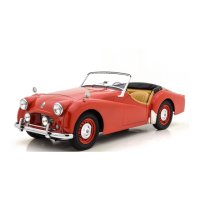Taken as a whole, the Triumph TR2s and TR3s represent
one of the most successful sports car designs in history; so suc-
cessful that, by the early nineteen-sixties, they had helped to
make Standard Triumph the second-best selling imported car
marque in the United States. During the late nineteen-fifties
and early nineteen-sixties, countless fledgling race drivers
gained their early experience in these machines. Among them
was three-time World Champion Jim
Clark, who owned one of
the first-if not the very first-TR3 in
Scotland.
Today, in the nineteen-seventies,
TR2s and TR3s are as
eagerly sought after as they were twenty years ago when the
cars were
in production. This should not be surprising since
there has never been a time during those twenty years when
TR2s and TR3s were not proving their worth. In 1965, fully ten
years after the TR2 was discontinued and almost five years
after the last TR3 had been built, the cars remained highly
competitive in racing. In that year, the Sports Car Club of
America's U.S. F-Production Championship was won by
Brian Fuerstenau in a TR3-with Lee Midgely's TR2 solidly in
second place.
Wise collectors began to acquire
TR2s and TR3s even before
their long and successful history had been written on the race
track.
(As recently as 1975 a TR3 made
the field for The Cham-
pion Spark Plug Road
~acin~ Classic-an event that deter-
mines the ultimate
standings in
U.S. amateur road racing.) In
1970, at a time when the newest TR3 was on the verge of
becoming a ten-year-old relic, well-maintained examples of its
predecessor, the TR2, were already being purchased by collec-
tors for more than the cars had cost when new. The prices of
fully restored
TR3s have since begun to follow suit and will un-
doubtedly
continue to rise as fewer examples of the type
become
available on the open market.
This is as it should be; the
TIP2 and TR3 are landmarks in
the
evolution of the sports car. Before the TR2 arrived on the
automotive scene, enthusiasts of limited means had very few
cars from which to choose. The TR3 was a windfall particular-
ly to sports car-starved Americans who, in buying a Triumph,
could acquire 100-mph capability at a cost little greater than
that required to obtain an 80-mph
MG.TF.
Because the value of TR2 and TR3 sports cars is increasing,
it is impossible to overstate the importance of correct
maintenance and repair.
Unfortunately, original workshop
manuals and owner's manuals have, since the assimilation of
Standard Triumph by British Leyland Motors, become virtual-
ly impossible to obtain. Indeed, original books are now
collec-
.
.
tor's items in their own right. No vintage Triumph enthusiast
would choose to risk one by placing it on an oil-stained
workbench or on a garage floor! A new, readily available and
easily replaceable manual that duplicates the orginal manuals'
This Manual has been compiled in order to meet that need,
thereby supplying complete, accurate, and comprehensive
maintenance and repair data to both car owners and profes-
sional mechanics. The
Driver's Instruction Book,
which com-
prises the first part of this Manual, is similar to the handbook
provided with every new TR3. The
Service Instruction Manual,
which comprises the second-and largest-portion of this
Manual, is the official factory manual and was originally in-
tended for use by dealer service departments. Owners of
TR3s
and the so-called TR3A or TR3B model will find it informative
to read the Foreword to the TR3 Supplement, which appears
on page
419.
Assembly work on small, highly-tuned machines such as the
Triumph sports
cars must be carried out with greater precision
than is commonly practiced on large American cars. Particular
emphasis must be given to the proper use of torque wrenches
and to strict adherence to the tightening torque specifications
which are given in this Manual. A fastener that is too tight can
be worse than one that is too loose-especially on a lightweight
sports car. Stretched or broken bolts and distorted parts, which
result from overtightening by musclebound mechanics, become
a serious concern where the precision fitting of light alloy and
thin-wall iron castings is involved.
The importance of cleanliness cannot be overemphasized.
Under no circumstances should an engine or gearbox be
repaired on the ground or on a garage floor. Thoroughly clean
the exteriors of major components prior to disassembly in
order to keep road dirt and other grime out of the working
parts. No more than a pinch of abrasive dust in a gearbox can
cause rapid failure of the synchronizers and bearings.
During the final assembly of an engine or gearbox, the
cleaned parts should be laid out on a clean workbench that has
been covered with clean sheets of new cardboard or wrapping
paper. The engine or gearbox itself, if not mounted on a special
stand, should likewise be placed on a clean workbench. Sand-
papering, valve grinding, or the use of bench grinders should
not be permitted near the area where final assembly is taking
place. If assembly cannot be completed in a day, enclose the
partially-assembled engine or gearbox in a large plastic
bag-such as a new trash bag or a dry cleaner's garment return
bag-so that dust and dirt will be excluded until assembly
work resumes.
By observing these precautions during the maintenance,
repair, or restoration of your TR2 or TR3, you will be preserv-
ing the value and the life of a car that is rapidly becoming one
of the classics among post-World War
I1
sports cars. If at any
time you lack the skills, special equipment, tools, or workshop
facilities for making repairs as they are described in this
Manual, we suggest you leave such repairs to an Authorized
contents is clearly needed.
Dealer or other qualified shop.

